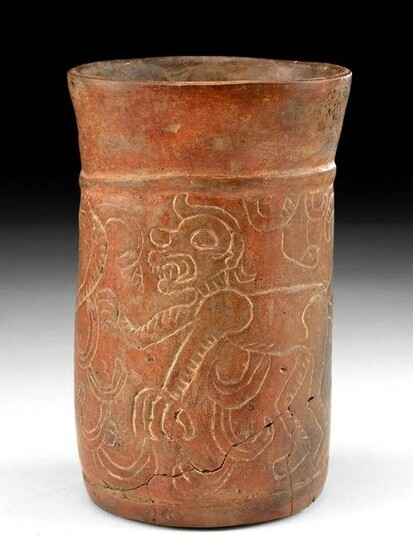Maya Cylinder Monkey Twins Defecating, ex-Schmitt
**Originally Listed At $800**
Pre-Columbian, Southern Mexico to Guatemala, Maya, Late Classic Period, ca. 550 to 900 CE. A hand-built pottery cylinder bearing the mythological Monkey Twins as they parade around and defecate with every step. The simian siblings stride around a field of crescent-shaped objects, perhaps bananas or other fruits, as they seek to sow playful chaos at every turn. The decorations are intricately incised across the main body and are separated from the unadorned rim via a raised band. Size: 4.3" W x 6.75" H (10.9 cm x 17.1 cm)
It is fitting that this monkey appears on a work of Maya art, as monkeys are associated with creativity in the Popol Vuh where the older brothers of the Hero Twins are named "One Monkey" (Hun batz) and "One Artisan" (Hun chouen), translated at times to One Howler monkey and One Spider monkey. These half brothers were believed to be carvers, writers, flautists, singers, in short, men of genius. When they were defeated by the Hero Twins and converted into monkeys, they rose to the occasion and became patrons of the arts, and in time, the object of writers' and carvers' prayers.
To the contrary, however, scholars Prudence M. Rice and Katherine E. South explain: "The monkey twins and the Hero Twins are portrayed as quintessential entertainers: they sing, they dance, and they perform miracles. But monkeys are also viewed negatively as tricksters, doubtless due to their playful child-like behavior and underscored by their magical strategems to elude the traps set for them in Xib'alb'a. Monkeys are also associated with drunkenness, licentiousness, violation of mores, and ritual humor in mocking political positions and office-holders. In the decorative band on a plate from Uaxactun, a monkey gropes a woman's breast; on another vessel a squatting monkey is defecating. Similarly at Chich'en Itza, the "Gallery of the Monkeys" (Structure 5C6) shows standing monkeys that drop something from their backsides." (Prudence M. Rice and Katherine E. South. "Revisiting Monkeys on Pots: A Contextual Consideration of Primate Imagery on Classic Lowland Maya Pottery." Ancient America, Vol. 26 (2015), p. 286)
Provenance: ex-Marc Amiguet Schmitt estate, Amiguet's Ancient Art, Evansville, Indiana, USA, acquired prior to January 1, 2010
All items legal to buy/sell under U.S. Statute covering cultural patrimony Code 2600, CHAPTER 14, and are guaranteed to be as described or your money back.
A Certificate of Authenticity will accompany all winning bids.
We ship worldwide to most countries and handle all shipping in-house for your convenience.
#174853
Condition Report: Repair to lower body and base, with small chips and light adhesive residue along break lines. Restoration to some areas of lower body as shown, and stabilization to hairline fissure stemming from rim. Minor abrasions, nicks, and spalls, with fire-darkening in some areas, and possible retooling to some incised motifs. Great monkey motifs!
View it on
Estimate
Time, Location
Auction House
**Originally Listed At $800**
Pre-Columbian, Southern Mexico to Guatemala, Maya, Late Classic Period, ca. 550 to 900 CE. A hand-built pottery cylinder bearing the mythological Monkey Twins as they parade around and defecate with every step. The simian siblings stride around a field of crescent-shaped objects, perhaps bananas or other fruits, as they seek to sow playful chaos at every turn. The decorations are intricately incised across the main body and are separated from the unadorned rim via a raised band. Size: 4.3" W x 6.75" H (10.9 cm x 17.1 cm)
It is fitting that this monkey appears on a work of Maya art, as monkeys are associated with creativity in the Popol Vuh where the older brothers of the Hero Twins are named "One Monkey" (Hun batz) and "One Artisan" (Hun chouen), translated at times to One Howler monkey and One Spider monkey. These half brothers were believed to be carvers, writers, flautists, singers, in short, men of genius. When they were defeated by the Hero Twins and converted into monkeys, they rose to the occasion and became patrons of the arts, and in time, the object of writers' and carvers' prayers.
To the contrary, however, scholars Prudence M. Rice and Katherine E. South explain: "The monkey twins and the Hero Twins are portrayed as quintessential entertainers: they sing, they dance, and they perform miracles. But monkeys are also viewed negatively as tricksters, doubtless due to their playful child-like behavior and underscored by their magical strategems to elude the traps set for them in Xib'alb'a. Monkeys are also associated with drunkenness, licentiousness, violation of mores, and ritual humor in mocking political positions and office-holders. In the decorative band on a plate from Uaxactun, a monkey gropes a woman's breast; on another vessel a squatting monkey is defecating. Similarly at Chich'en Itza, the "Gallery of the Monkeys" (Structure 5C6) shows standing monkeys that drop something from their backsides." (Prudence M. Rice and Katherine E. South. "Revisiting Monkeys on Pots: A Contextual Consideration of Primate Imagery on Classic Lowland Maya Pottery." Ancient America, Vol. 26 (2015), p. 286)
Provenance: ex-Marc Amiguet Schmitt estate, Amiguet's Ancient Art, Evansville, Indiana, USA, acquired prior to January 1, 2010
All items legal to buy/sell under U.S. Statute covering cultural patrimony Code 2600, CHAPTER 14, and are guaranteed to be as described or your money back.
A Certificate of Authenticity will accompany all winning bids.
We ship worldwide to most countries and handle all shipping in-house for your convenience.
#174853
Condition Report: Repair to lower body and base, with small chips and light adhesive residue along break lines. Restoration to some areas of lower body as shown, and stabilization to hairline fissure stemming from rim. Minor abrasions, nicks, and spalls, with fire-darkening in some areas, and possible retooling to some incised motifs. Great monkey motifs!



